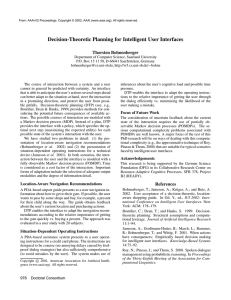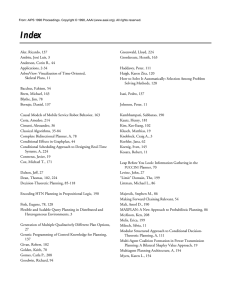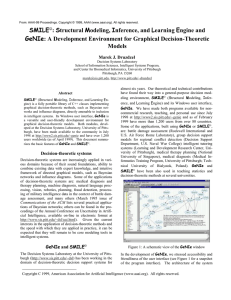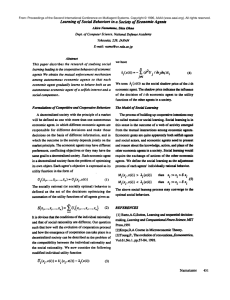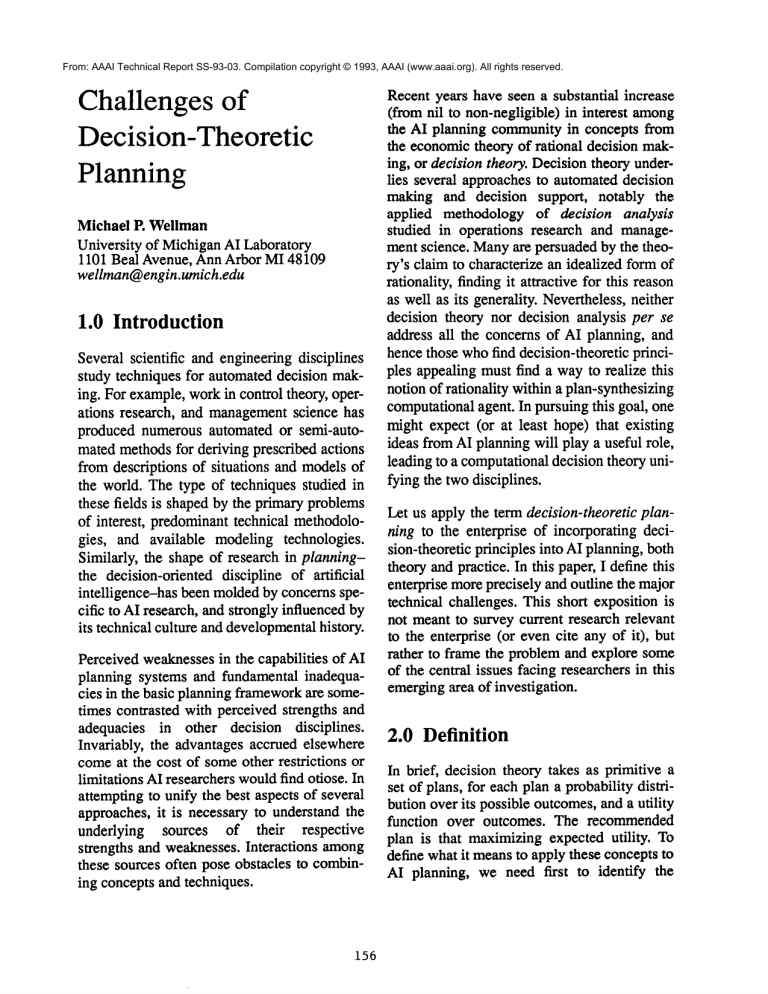
From: AAAI Technical Report SS-93-03. Compilation copyright © 1993, AAAI (www.aaai.org). All rights reserved.
Challenges of
Decision-Theoretic
Planning
Michael P. Wellman
University of MichiganAI Laboratory
1101 Beal Avenue, Ann Arbor M148109
wellman@engin.umich.edu
1.0 Introduction
Several scientific and engineering disciplines
study techniques for automated decision making. For example,workin control theory, operations research, and managementscience has
produced numerous automated or semi-automated methodsfor deriving prescribed actions
from descriptions of situations and modelsof
the world. The type of techniques studied in
these fields is shaped by the primary problems
of interest, predominanttechnical methodologies, and available modeling technologies.
Similarly, the shape of research in planningthe decision-oriented discipline of artificial
intelligence-has been moldedby concerns specific to AI research, and strongly influenced by
its technical culture and developmentalhistory.
Perceived weaknessesin the capabilities of AI
planning systems and fundamental inadequacies in the basic planning frameworkare sometimes contrasted with perceived strengths and
adequacies in other decision disciplines.
Invariably, the advantages accrued elsewhere
comeat the cost of someother restrictions or
limitations AI researchers wouldfind otiose. In
attempting to unify the best aspects of several
approaches, it is necessary to understand the
underlying sources of their respective
strengths and weaknesses. Interactions among
these sources often pose obstacles to combining concepts and techniques.
156
Recent years have seen a substantial increase
(from nil to non-negligible) in interest among
the AI planning communityin concepts from
the economictheory of rational decision making, or decision theory. Decision theory underlies several approaches to automated decision
making and decision support, notably the
applied methodology of decision analysis
studied in operations research and management science. Manyare persuaded by the theory’s claim to characterize an idealized form of
rationality, finding it attractive for this reason
as well as its generality. Nevertheless, neither
decision theory nor decision analysis per se
address all the concerns of AI planning, and
hence those whofind decision-theoretic principles appealing must find a wayto realize this
notion of rationality within a plan-synthesizing
computationalagent. In pursuing this goal, one
might expect (or at least hope) that existing
ideas from AI planning will play a useful role,
leading to a computationaldecision theory unifying the two disciplines.
Let us apply the term decision-theoretic planning to the enterprise of incorporating decision-theoretic principles into AI planning, both
theory and practice. In this paper, I define this
enterprise moreprecisely and outline the major
technical challenges. This short exposition is
not meant to survey current research relevant
to the enterprise (or even cite any of it), but
rather to frame the problem and explore some
of the central issues facing researchers in this
emerging,area of investigation.
2.0 Definition
In brief, decision theory takes as primitive a
set of plans, for each plan a probability distribution over its possible outcomes,and a utility
function over outcomes. The recommended
plan is that maximizing expected utility. To
define what it meansto apply these concepts to
AI planning, we need first to identify the
essential aspects of planning. Abstracting from
some of the details of commonAI planning
languages, we can derive a general definition
of the task:
Given (1) a schematic description
of primitive actions and their
effects, and (2)a description
objectives, the Alplanningtask is
to (3) synthesize a plan serving
those objectives, where a plan is
a compoundobject consisting of
action instances connected by
basic relational primitives.
The basic relational primitives are composition
operators, such as sequencing or conditioning,
that specify howthe individual actions are
related in the compositeplan object. Note that
this definition is far moregeneral than typical
characterizations of AI planning, whichtend to
incorporate features of particular planning
approaches. For example, we might define
classical planning as a specialization of the
above where objectives are described by goal
propositions and sequencing is the basic composition operator. Other specializations might
constrain the representation of effects (e.g., by
preconditions, add-, and delete-lists) or the
intermediate structures explored during plan
synthesis (e.g., linear or nonlinear plan fragments). Whereasdistinctions such as these are
technically significant and useful, they are not
definitive for AI planning. Rather, the essential
characteristic of AI planningthat distinguishes
it fromother decision disciplines is its focus on
structured plan objects composedfrom schematically described action primitives. This
leads to a compactbut expressive description
of a combinatorial but highly structured plan
space. As long as the effects of actions compose in a modular manner, this regularity can
be exploited in plan synthesis.
As for classical planning, we can define decision-theoretic planning via specialization:
157
Decision-theoretic planning is a
special case of the general AI planning task where (1) effects
actions are described by probability distributions over outcomes,(2)
objectives are described by utility
functions, and (3) the criterion for
effective
plan synthesis
is
expected-utility maximization.
By "described by" in the above, we do not
meanto insist that the languages for effects
andobjectives literally anddirectly represent
complete probability distributions and utility
functions. Rather, we require only that the representation language have someinterpretation
in terms of those concepts, such as constraining them in some way.
Seen as sibling specializations of a general
planning task, the most critical differences
betweenclassical and decision-theoretic planning are that the latter admitsexplicit representation of uncertainty in the effects of actions
and graded preferences for alternate outcomes.
These extended specifications
provide a
sharper rationality criterion than satisficing,
imposing a more refined preference among
plans than possible when the objective is
merely a goal proposition.1
3.0 Challenges
Classical planningand its variants are difficult
for two primary reasons: (1) the need to search
a combinatorial or infinite plan space (i.e.,
even restricted planning problems tend to be
NP-hard), and (2) a variety of subtle technical
problems arise in reasoning about the effects
1. Newellelucidates the rationality theory corresponding to satisficing in his original exposition of knowledge-level analysis. A rationality theory based on goals
alone is fundamentallylimited in that a goal cannot distinguish amongplans that achieve it, nor prescribe
behavior whena satisficing plan cannot be found.
of actions (e.g., ramifications, persistence,
qualifications, combinedor context-dependent
effects). These problemsare no less serious in
decision-theoretic planning, and in somecases
they are moredifficult. In this section I outline
someof the technical challenges specific to the
decision-theoretic approach. The magnitudeof
these difficulties suggests that we should not
expect to construct a decision-theoretic planner by some incremental modification to a
deterministic-action goal-satisficing planner
(e.g., by simplyinserting probabilities and utilities somewhere).However,they should not be
taken as an argumentagainst the enterprise, as
even partial success in accounting for likelihood and preference can significantly extend
the applicability of AI planning technology.
It should be noted that someof the difficulties
enumerated below can be alleviated or eliminated given sufficient restrictions on the problem domain. Indeed, the literatures of the
decision disciplines mentionedabove catalog a
myriad of special cases. However,AI research
has traditionally been concerned with generalpurpose mechanisms, and hence it would be
inadmissible to hardwire the necessary
assumptions into a planning architecture.
Instead, we should seek to develop general
mechanismsthat can exploit regular structures
and restricted forms whenthey exist. It is in
this regard that the knowledgeand techniques
developed by the other decision disciplines
will be of greatest use to artificial intelligence.
3.1 Schematic action representations
Perhaps the main feature of AI planning that
we must accommodatein adopting the decision-theoretic conceptsof probability and utility is that of schematicaction representations.
Standardrepresentations of probability distributions and utility functions apply to event and
outcome instances, as opposed to types. In
other words, the well-developed languages for
probabilistic and utility-theoretic reasoning
possess propositional
expressive power.
Althoughit is relatively easy to obtain a firstorder language by writing downthe axiomsfor
probability and utility, the challenge is to
design a language that supports general
expressions about patterns of likelihood and
preference with respect to various actions and
conditions.
3.2 Uncertaineffects of actions
Oncewe admit that we cannot flawlessly predict the effects of actions, several problems
emergethat did not arise in the deterministic
case.
First, uncertain relationships are inherently
less modularthan their deterministic counterparts. Whereaslogical connectives are truth
functional in the deterministic case--e.g., the
truth value of a conjunctionis a function of the
truth value of the conjuncts-the samedoes not
hold of probabilities. Theprobability of a conjunction is constrained by the probabilities of
its conjuncts(it cannot exceedthem), but is not
uniquely determined in general. This means
that we must consider the interactions among
the parts in assessing our belief in the whole.
Similarly, whereasin the deterministic case we
need only find one successful argument(proof)
for a proposition, under uncertainty we must in
general find all relevant evidence pro and con
and weighit together in order to establish the
proper degree of belief for the proposition. In
general, it is moredifficult in the uncertain
case to achieve separability in representation
and reasoning. For this reason, we should
expect increased complexity in specifying and
reasoning about effects of actions in planning
under uncertainty.
Second, maintaining graded degrees of belief
rather than binary truth values imposes an
added burden of precision. Precision generally
increases the complexity of knowledgespecification, if only because morebits are required.
158
Worse, precise relationships tend to be more
context sensitive than coarse ones, since features that might not have affected a categorical
belief value maynevertheless influence the
exact degree of belief. This is especially problematic whenwe consider the temporal dimension usually present in planning problems.
Whereasit is reasonable to consider changesin
binary truth values at only discrete time points,
degrees of belief typically change more frequently, even continuously. Like non-modularity, the precision factor requires us to consider
more and higher-order relationships,
thus
inhibiting scalability of our planning knowledge.
Third, the inability to perfectly predict effects
meansthat some important information about
the world maybecomeavailable only at execution time. In order to makeuse of such information, our plans must include conditional
constructs enabling action to dependon downstream observations. Execution-time replanning is not sufficient, as (1) it takes time,
whichmaynot be available, and (2) the ability
to react to observations downstream may
impactthe preferred actions taken at the beginning of the plan. Accountingfor contingencies
dramatically blows up the plan space, rendering an intractable problemthat muchmoreso.
Finally, the opportunity to condition action on
dynamically obtained information suggests
that it maybe advantageous to expressly plan
actions that resolve salient uncertainty. As
above, considering information-gathering
actions adds another level of combinatorial
explosion to an already enormous search
space.
Note that these problems are attributable to
uncertainty and degrees of belief generally,
and are not specific to the probabilistic
approach. Some formalisms may appear
immuneto someof these problems (e.g., logical connectives in the fuzzy calculus are truth
159
functional), but only by defining away the
potential interactions or opportunities for contingency planning that makethe general problemdifficult.
3.3 Preferences over outcomes
Accountingfor relative preference is perhaps
the most fundamentalfeature of decision-theoretic planningdistinct from traditional AI planning approaches. Most AI planning theory and
technology presumesthat objectives are represented by goal propositions; indeed, this representation is often taken as part of the definition
of the planning task. That goal satisfaction is
so firmly rooted in AI is probably attributable
to two main factors: 2 (1) the prevalence
predicate-logic representations, which naturally capture binary distinctions amongstates,
and (2) the seminal influence of Herbert
Simon, whose theory of satisficing behavior
challenged the optimizing frameworkstandard
in economics.
Generalizingobjectives to permit relative preference amongstates presents two significant
challenges. First, we need a language to specify these preferences. Andsecond, given specified preferences, we require an effective
procedure for finding plans with preferred outcomes.
Oneof the central results of decision theory is
that, given someconditions on rational choice,
the preference order is representable by a realvalued utility function. But this result does not
solve our planning representation problem, as
numeric utility functions suffer from the same
plagues of precision and modularity enumerated for probability above. Plausible representation for relative values must capture the
robust patterns of preference amongoutcomes,
and provide for modular combination of mea-
2. warning:
recklesshistoricalspeculation
ahead
sures of distinct attributes of value. Goalpropositions constitute one important class of
preference pattern for whichdecision-theoretic
planning must account; research to discover
the other important classes has barely
scratched the surface.
Simon’sargument for satisficing as a form of
"bounded rationality" was based on empirical
investigation of humandecision makers as
well as the insightful observation that satisfying a preset aspiration level is an easier computational problem than global optimization.
Measuringthe difference in complexityis difficult outside someparticular context, but this
assertion can be madeprecise in specific formulations. Oneadvantageof satisficing is that
it is locally testable; in contrast, one cannot
generally tell by inspection of an isolated solution that it is optimal on somegraded measure.
To determine optimality without exhaustive
search requires that weexploit regularity in the
search space and some knowledge about the
regularstructure.
3.4 Analyzingpartial plans
In some attempts to integrate planning and
decision theory, the two ideas are applied serially-plans are generated and then evaluated.
Given the size of typical plan spaces, this
approach can ultimately evaluate only a
minusculefraction of the possible plans. What
basis have we to expect these to include the
goodones? Thecriterion for plan quality, after
all, is specified in the decision-theoretic part.
In order to find good plans, we must bring in
some decision-theoretic
evaluation before
plans are fully assembled. This is not completely straightforward, as the standard concepts are not defined for partial plans.
Thedifficulty in assessing the value of a partial
plan is that there are manywaysin whichthat
plan maybe completed. In the usual case, the
set of completionsinclude somethat are arbi-
160
trarily bad, and somethat are quite good. Comparison of partial plans must be based on some
indications of whichpartial plans havethe best
completions, or perhaps those best and easiest
to find.
It is unclear whether in decision-theoretic
planning we can define useful analogs to the
sort of modaltruth criteria applied in classical
planning. That is, whether we can effectively
assess properties (even uncertain ones) holding
at a point of a partially specified plan. The
inherent non-modularityof uncertain relationships makesthis moredifficult than the classical ease, but it is still too early to tell whetherit
is a reasonable approach.
4.0 Conclusion
The technical challenges facing the enterprise
of decision-theoretic planning are deep and
numerous. In this paper, I have not attempted
to outline the possible strategies for meeting
these challenges, nor to describe the ideas that
have already been advanced for overcomingor
alleviating someof the specific difficulties
addressed. Such a survey will find another
occasion. For the nonce, suffice it to say that
several AI researchers have undertaken some
of these challenges in recent years, and partial
solutions are emerging.At the momentit is too
early for me to assess with confidence the
prospects for a general-purpose decision-theoretic planner truly worthy of the name.Nevertheless, I maintain a high degree of confidence
that the enterprise is worthyof effort, as (1) the
ultimate goal is perhaps the closest characterization of "an ideally rational agent", which
should be a holy grail for AI, (2) even partial
success could dramatically extend the scope of
AI planning and increase the competence of
planning systems, and (3) we haven’t yet tried
hard enoughto give up.

